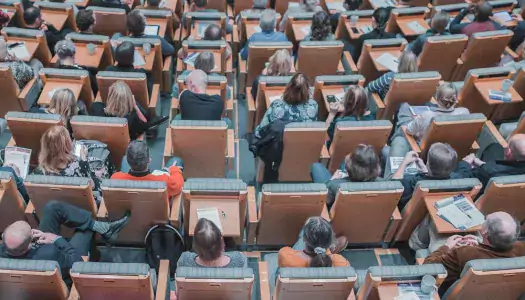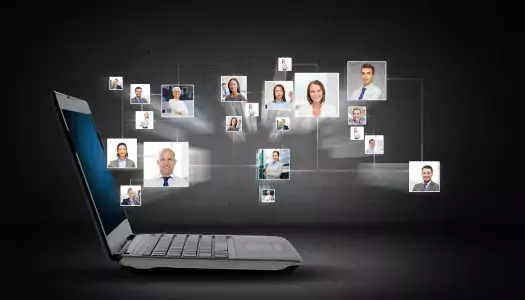You go out on a date, have a great time, there’s a good feeling all around, and nice memories when you replay the highlights in your head.
Then, crickets. You never hear another word.
Until a year later, when they start sending emails about getting together again.
Wait, am I talking about getting ghosted by a date or by an association? Since we’re on the TopClass blog, not Facebook Messenger, you know where I’m going with this.
Associations spend weeks and months planning courses, conferences, and other educational programs. The marketing campaigns go on for months too. The big day or big moments arrive. A grand success!
But when the program is over, poof! You disappear from their inboxes and their lives. Cold cold heart.
Why keep talking to program participants
When you don’t keep a conversation going after a program, you miss out on strengthening your relationship with learners and attendees. But what’s worse is you miss the opportunity to help participants build relationships with each other. Before these relationships had a chance to grow, you pulled the plug.
It’s easy to spot the signs of a budding community in chat boxes, breakout rooms, and discussion groups and forums. But then it disappears forever when the program is over, never to appear again, unless you make it happen.
Keep the conversations going. Nurture learners and attendees. Hold them close as part of your community, whether or not they’re members. These people made an investment of time and money in your association. They’re hot leads for future programs.
Don’t take them for granted. Today, people have tons of choices for events and education. Look at the association industry, for example. ASAE and state SAEs aren’t the only game in town. In last week’s post, we listed the competition who provides free education. The list of paid education and community providers is even longer.
Post-program campaigns deepen relationships, build loyalty and trust, create superfans, and make people feel special. They remind people of the good experience they had. They ensure the memory or impact of the program doesn’t get lost in the shuffle when life returns to business as usual.
Following up with participants after a program helps them apply what they learned and ensures their ROI isn’t lost.
In the daily grind of association work, it’s easy to forget that programs aren’t just an item on a checklist or a transaction for your association. Programs are the beginning of a new or strengthened relationship with participants.
How to prepare for post-program campaigns
None of this good stuff happens unless you prepare ahead of time. You want to be ready to go soon after the program ends.
Goal #1 is to help participants renew acquaintances, find each other on LinkedIn, and stay connected. At registration, ask them what contact info they’re willing to share with fellow participants, for example: name, organization, position, location, LI profile URL (tell them how to find it), and other social media URLs.
Goal #2 is to help participants retain what they’ve learned. They need “reinforcement,” says Tracy King of InspirEd. “Invest in post-training follow-up to solidify new behaviors. Research shows sustained change comes from diligent follow-ups—coaching, job aids, microlearning—key elements in transforming learning.”
Prepare post-program handouts, such as guides, checklists, and tip sheets, to help them apply their new knowledge back on the job. For conferences and other educational events, gather and post slides, recordings, and handouts.
Prepare the post-program survey. Only request information you will act upon. Most associations do evaluations wrong, per expert Will Thalheimer, although he doesn’t exactly come out and say that.
Ask participants:
• How they’re applying their new knowledge/skills
• What they want to explore deeper in future programs
• What topics they’d like to discuss with others
• Whether they’d like the support of peers on any project or idea
Ask for testimonials about a-ha moments that made their investment of money and time worth it.

What to do right after the program ends
Just when you’re ready for a break, but sorry, you need to take advantage of post-program buzz and momentum.
Review program/event data to identify hot topics in chats, online forums, or breakroom discussions. ChatGPT or data analytic tools can help you summarize long bodies of text.
Identify people in chat, discussion groups, and elsewhere who contributed useful advice or resources. Give them awards—no trophies or plaques required, just a shoutout and a discount code to use for an upcoming program.
Schedule a series of post-program emails. Keep them short.
• Thank you email with a big thanks to award recipients and whoever else deserves it
• Program evaluation
• Program resource library reminder
• Program data you want to share and what you learned from it—people like to know what’s trending
• Announcement of upcoming programs, like meetups and cohorts
• Updates to the resource library
Create a resource library of recordings, photo gallery, statistics, testimonials, and sponsored and program-related downloadable content.
What to do after you’ve had a chance to breathe
Follow up on the evaluation remarks you want to explore deeper. This gives you a reason to contact participants and tighten the bond, hopefully.
Contact people who gave testimonials with a thanks and an edited version for their approval.
Repurpose content. Identify memorable—or what we used to call “tweet-worthy”—moments. Create 5- to 10-second and 30-second video clips to share on social media or use in marketing promos.
Look for program content you (or colleagues) can repurpose for:
• Podcast episodes
• Blog posts: create recap or insight posts from transcripts
• LinkedIn posts
• Webinars and mini courses
• Animated videos, infographics, GIFs, social graphics
• Greatest hits handouts
• Toolkits, checklists, tip sheets, templates
Use some of this repurposed content as lead magnets for upcoming programs and events. Attract leads with the magnet (content) but require an email address to download it.
Gather the community again
Help participants find each other in real life. Be the facilitator of relationships that deliver valuable ROI to participants. Share contact information per the participant’s permission.
Schedule online meetups where they can discuss hot topics. Ask sponsors to facilitate.
Find out who’s embarking on similar new projects. Play matchmaker for cohort or accountability groups.
Schedule replays of popular sessions for those who missed them. Invite speakers and sponsors to return so they can facilitate discussions in the chat or breakrooms when the recording is paused.
Following up with participants and gathering them together again will help nurture leads for future programs. But more importantly, you’ll nurture relationships with participants and between participants.






